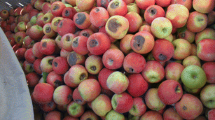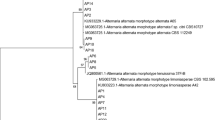Abstract
Apple (Malus domestica Borkh) is a major fruit crop in Chile. Among apple diseases, moldy core (MC) in the fruit has a high prevalence (16 to 46%) in susceptible cultivars. Apparently healthy flowers and fruit were sampled at six growth stages, from the pink bud to the mature fruit, from the susceptible ‘Oregon Spur’ and from the resistant ‘Granny Smith’ apples during two growing seasons. At least seven fungal genera were detected colonizing flowers and the fruit of both cultivars. Small-spored Alternaria spp. were the primary species identified throughout all the growing stages. Independently of the growth stages, sepals, stamens and carpels of flowers were similarly colonized by Alternaria spp. in the susceptible (‘Oregon Spur’) and resistant (‘Granny Smith’) apple cultivars. However, in fruits of 4–6 cm in diameter, big differences in the frequency of Alternaria spp. in fruit carpels were observed between susceptible and resistant apples, with 55% and 1%, respectively. At least five Alternaria spp. were identified at the species level using plasma membrane ATPase, namely, A. alternata, A. arborescens, A. limoniasperae, A. tenuissima in sect Alternaria, A. kordkuyana in sect. Pseudoalternaria and Alternaria sp. in sect. Infectoriae. All Alternaria isolates, from sepals, stamens and carpels, from apparently healthy flowers and fruits were pathogenic, producing MC symptoms in apples. These results suggest that apparently healthy flowers and fruits may act as an important inoculum source of Alternaria spp. for MC infections and also suggest that control strategies against MC using fungicide applications should be carried at flowering, from pink bud onwards.


Similar content being viewed by others
References
Abe, K., Iwanami, H., Kotoda, N., Moriya, S., & Takahashi, S. (2010). Evaluation of apple genotypes and Malus species for resistance to Alternaria blotch caused by Alternaria alternata apple pathotype using detached-leaf method. Plant Breeding, 129, 208–218.
Elfar, K., Torres, R., Díaz, G. A., & Latorre, B. A. (2013). Characterization of Diaporthe australafricana and Diaporthe spp. associated with stem canker of blueberry in Chile. Plant Disease, 97, 1042–1050.
Elfar, K., Zoffoli, J. P., & Latorre, B. A. (2018a). Occurrence of Alternaria blotch associated with Alternaria alternata, A. arborescens, A. infectoria and A. tenuissima on apples in Chile. Plant Disease, 102, 1668.
Elfar, K., Zoffoli, J. P., & Latorre, B. A. (2018b). Identification and characterization of Alternaria species associated with moldy Core of apple in Chile. Plant Disease, 102, 2158–2169.
Ellis, M. A., & Barrat, J. G. (1983). Colonization of delicious apple fruits by Alternaria spp. and effect of fungicide sprays on moldy-core. Plant Disease, 67, 50–152.
Filatov, D. A. (2002). ProSeq: A software for preparation and evolutionary analysis of DNA sequence data sets. Molecular Ecology Notes, 2, 621–624.
Gao, L. L., Zhang, Q., Sun, X. Y., Jiang, L., Zhang, R., Sun, G. Y., Zha, Y. L., & Biggs, A. R. (2013). Etiology of moldy core, core browning, and core rot of Fuji apple in China. Plant Disease, 97, 510–516.
Harteveld, D. O. C., Akinsanmi, O. A., & Drenth, A. (2013). Multiple Alternaria species groups are associated with leaf blotch and fruit spot diseases of apple in Australia. Plant Pathology, 62, 289–297.
Harteveld, D. O. C., Akinsanmi, O. A., Chandra, K., & Drenth, A. (2014). Timing of infection and development of Alternaria diseases in the canopy of apple trees. Plant Disease, 98, 401–408.
Hirakue, A., & Sugiyama, S. (2018). Relationship between foliar endophytes and apple cultivar disease resistance in an organic orchard. Biological Control, 127, 139–144.
Holb, I. J. (2007). Classification of apple cultivar reactions to scab in integrated and organic apple production systems. Canadian Journal of Plant Pathology, 29, 251–260.
Holb, I. J. (2017). Categorization of apple cultivars based on seasonal powdery mildew disease progression in two disease management systems over 12 years. Trees Structure and Function, 31, 1905–1917.
Kumar, S., Stecher, G., & Tamura, K. (2016). Molecular evolutionary genetics analysis version 7.0 for bigger datasets. Molecular Biology and Evolution, 33, 1870–1874.
Larkin, M. A., Blackshields, G., Brown, N. P., Chenna, R., McGettigan, P. A., McWilliam, H., Valentin, F., Wallace, I. M., Wilm, A., Lopez, R., Thompson, J. D., Gibson, T. J., & Higgins, D. G. (2007). Clustal W and Clustal X version 2.0. Bioinformatics, 23, 2947–2948.
Lawrence, D. P., Gannibal, P. B., Peever, T. L., & Pryor, B. M. (2013). The sections of Alternaria: Formalizing species-groups concepts. Mycologia, 105, 530–546.
Li, Y., Hirst, P. M., Wan, Y., Liu, Y., Zhou, Q., Gao, H., Guo, H., Zhao, Z., Wang, L., & Han, M. (2012). Resistance to Marssonina coronaria and Alternaria alternata apple pathotype in the major apple cultivars and rootstocks used in China. HortScience, 47, 1241–1244.
Niem, J., Miyara, I., Ettedgui, Y., Reuveni, M., Flaishman, M., & Prusky, D. (2007). Core rot development in red delicious apples is affected by susceptibility of the seed locule to Alternaria alternata colonization. Phytopathology, 97, 1415–1421.
Pinilla, B., Trombert, Y., & Alvarez, M. (1996). Efecto de la aplicación de fungicidas en la incidencia de corazón mohoso en manzanas almacenadas en frío. Agricultura Técnica, 56, 155–162.
Pryor, B. M. & Michailides, T. J. (2002). Morphological, pathogenic, and molecular characterization of Alternaria isolates associated with Alternaria late blight of pistachio. Phytopathology, 92, 406-416
Reuveni, M. (2006). Inhibition of germination and growth of Alternaria alternata and mouldy-core development in red delicious apple fruit by bromuconazole and sygnum. Crop Protection, 25, 253–258.
Reuveni, M., & Prusky, D. (2007). Improved control of moldy-core decay (Alternaria alternata) in red delicious apple fruit by mixtures of DMI fungicides and captan. European Journal of Plant Pathology, 118, 349–357.
Reuveni, M., Sheglov, D., Sheglov, N., Ben-Arie, R., & Prusky, D. (2002). Sensitivity of red delicious apple fruit at various phenologic stages to infection by Alternaria alternata and moldy-core control. European Journal of Plant Pathology, 108, 421–427.
Sawamura, K. (2014). Alternaria blotch. In T. B. Sutton, H. S. Aldwinckle, A. M. Agnello, & J. F. Walgenbach (Eds.), Compendium of apple and pear diseases and pests (2nd ed., pp. 32–33). Minnesota: APS Press.
Serdani, M., Crous, P. W., Holz, G., & Petrini, O. (1998). Endophytic fungi associated with core rot of apples in South Africa, with specific reference to Alternaria species. Sydowia, 50, 257–271.
Shtienberg, D. (2012). Effects of host physiology on the development of core rot, caused by Alternaria alternata, in red delicious apples. Phytopathology, 102, 769–778.
Simmons, E. G. (2007). Alternaria: An Identification Manual. Utrecht: CBS Fungal Biodiversity Centre.
Zhu, X. Q. & Xiao, C. L. (2015). Phylogenetic, morphological and pathogenic characterization of Alternaria species associated with fruit rot of blueberry in California. Phytopathology, 105, 1555–1567.
Acknowledgments
Karina Elfar thanks Conicyt for the scholarship provided to pursue her postgraduate studies at the Pontificia Universidad Católica de Chile and for the financial support received through Conicyt project number 21141074. We thank Magna Trading for providing the flowers and fruits that were used in this study.
Author information
Authors and Affiliations
Corresponding author
Ethics declarations
Ethical approval
This manuscript is original and not published elsewhere. The author discussed the result, read and approved the final article. The authors confirm that there are no ethical issues in publication of the manuscript.
Conflict of interest
The authors declare no conflict of interest.
Research involving human participants and/or animals
This study does not contain studies with human participants or animals performed by any of the authors.
Rights and permissions
About this article
Cite this article
Elfar, K., Zoffoli, J.P. & Latorre, B.A. Alternaria spp. on apparently healthy apples as a potential inoculum source for moldy core development and the effect of resistant and susceptible apple cultivars. Eur J Plant Pathol 155, 743–754 (2019). https://doi.org/10.1007/s10658-019-01802-2
Accepted:
Published:
Issue Date:
DOI: https://doi.org/10.1007/s10658-019-01802-2




